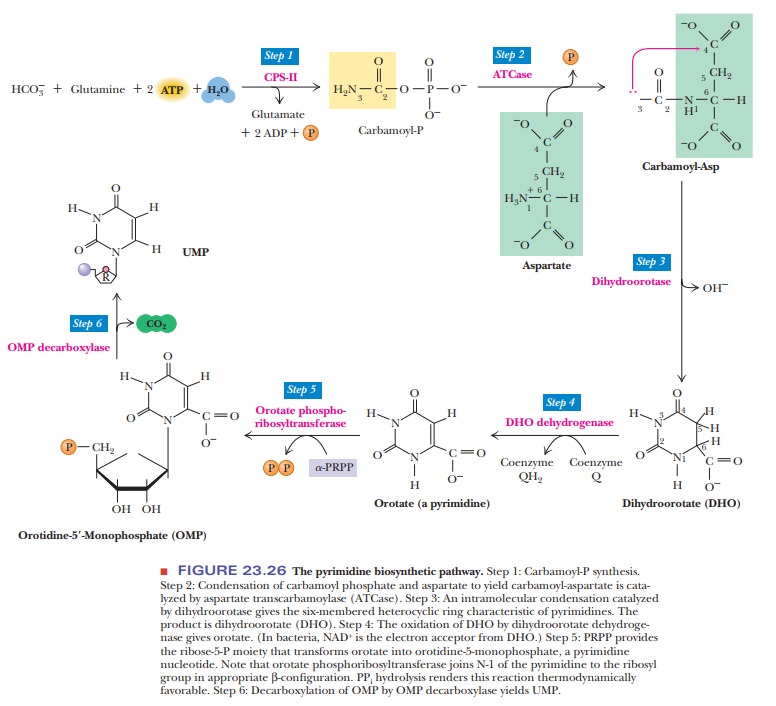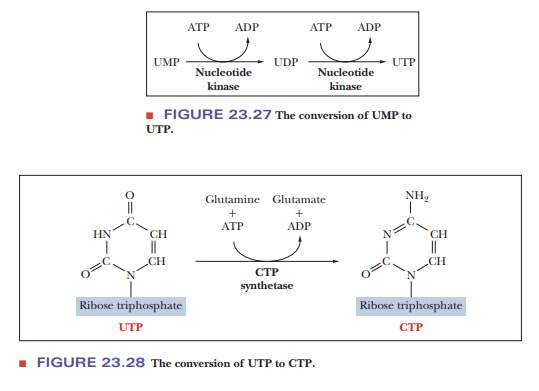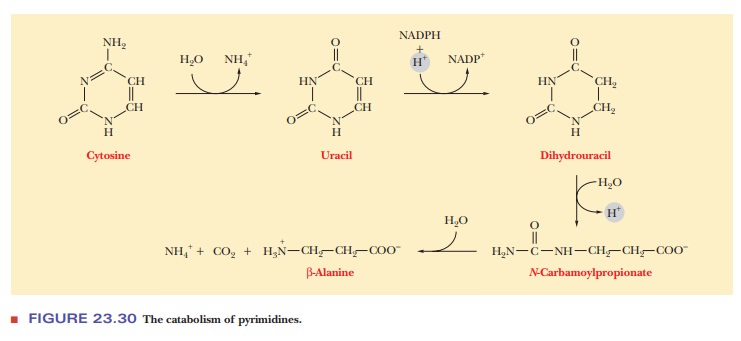Chapter: Biochemistry: The Metabolism of Nitrogen
Pyrimidine Biosynthesis and Catabolism
Pyrimidine Biosynthesis and
Catabolism
The Anabolism of Pyrimidine Nucleotides
The
overall scheme of pyrimidine nucleotide biosynthesis differs from that of
purine nucleotides in that the pyrimidine ring is assembled before it is
attached to ribose-5-phosphate. The carbon and nitrogen atoms of the pyrimidine
ring come from carbamoyl phosphate and aspartate. The production of carbamoyl
phosphate for pyrimidine biosynthesis takes place in the cytosol, and the
nitrogen donor is glutamine.
HCO3–
+ Glutamine + 2ATP + H2O - > Carbamoyl phosphate + Glutamate +
2ADP + Pi
The reaction of carbamoyl phosphate with aspartate to produce N-carbamo-ylaspartate is the committed step in pyrimidine biosynthesis. The compounds involved in reactions up to this point in the pathway can play other roles in metabolism; after this point, N-carbamoylaspartate can be used only to pro-duce pyrimidines—thus the term “committed step.” This reaction is catalyzed by aspartate transcarbamoylase, which we discussed in detail as a prime example of an allosteric enzyme subject to feedback regulation. The next step, the conversion of N-carbamoylaspartate to dihydroorotate, takes place in a reaction that involves an intramolecular dehydration (loss of water) as well as cyclization. This reaction is catalyzed by dihydroorotase. Dihydroorotate is converted to orotate by dihydroorotate dehydrogenase, with the concomitant conversion of NAD+ to NADH. A pyrimidine nucleotide is now formed by the reaction of orotate with PRPP to give orotidine-5'-monophosphate (OMP), which is a reaction similar to the one that takes place in purine salvage. Orotate phosphoribosyltransferase catalyzes this reaction. Finally, orotidine-5'-phosphate decarboxylase catalyzes the conversion of OMP to UMP (uridine-5'-monophosphate), which is the precursor of the remaining pyrimi-dine nucleotides (Figure 23.26).

Two
successive phosphorylation reactions convert UMP to UTP (Figure 23.27). The
conversion of uracil to cytosine takes place in the triphosphate form,
catalyzed by CTP synthetase (Figure 23.28). Glutamine is the nitrogen donor,
and ATP is required, as we saw earlier in similar reactions.

UTP +
Glutamine + ATP - > CTP + Glutamate + ADP + Pi
Feedback
inhibition in pyrimidine nucleotide biosynthesis takes place in several ways.
CTP is an inhibitor of aspartate transcarbamoylase and of CTP synthetase. UMP
is an inhibitor of an even earlier step, the one catalyzed by carbamoyl
phosphate synthetase (Figure 23.29).

Pyrimidine Catabolism
Pyrimidine
nucleotides are broken down first to the nucleoside and then to the base, as
purine nucleotides are. Cytosine can be deaminated to uracil, and the double
bond of the uracil ring is reduced to produce dihydrouracil. The ring opens to
produce N-carbamoylpropionate, which
in turn is broken down to NH4+, CO2, and β-alanine (Figure 23.30).

Summary
The ring system of pyrimidines is assembled before it is attached
to ribose phosphate.
During breakdown, the nucleoside is formed first, then the base. Ring-opening
reactions of the base complete the degradation.
Related Topics